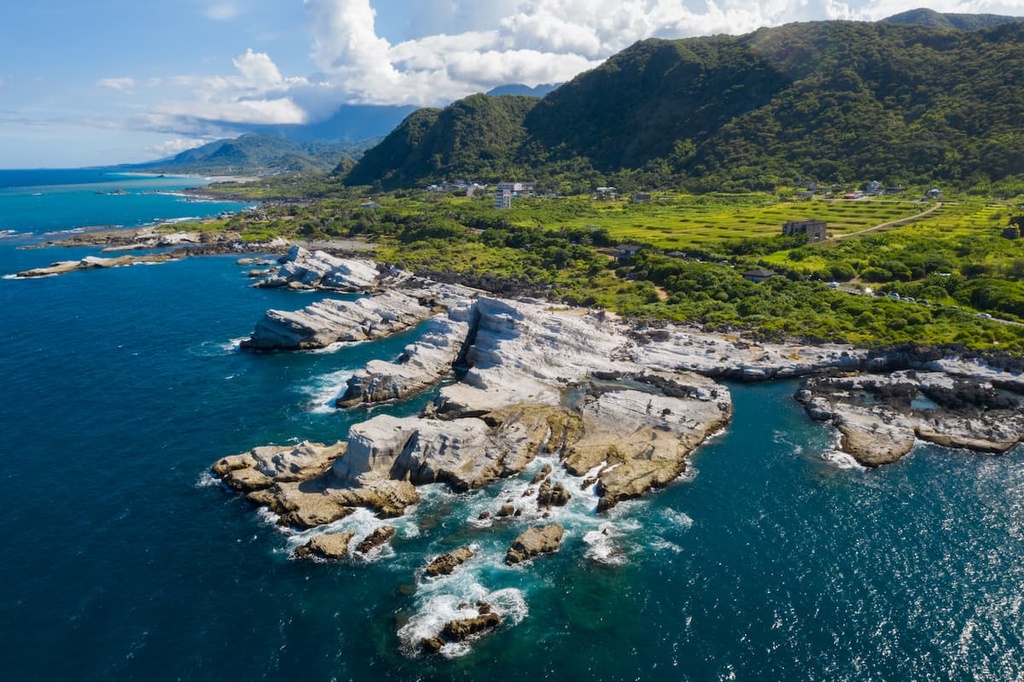Get PeakVisor App
Sign In
Search by GPS coordinates
- Latitude
- ° ' ''
- Longitude
- ° ' ''
- Units of Length

Yes
Cancel
Share ×

Scan the QR code and open PeakVisor on your phone
❤ Wishlist ×
Choose
Delete
Hugging the east coast of Taiwan lies an incredible area of natural beauty that consists of layered fields of rice paddies, gentle coastal hills, bubbling thermal springs, and striking rock formation: Huadong Coastal Reserve (花東沿海保護區). The reserve is home to 96 named mountains, the tallest and most prominent of which is Malaolou Shan (麻荖漏山) at 1,684 metres (5,525 ft) in elevation.
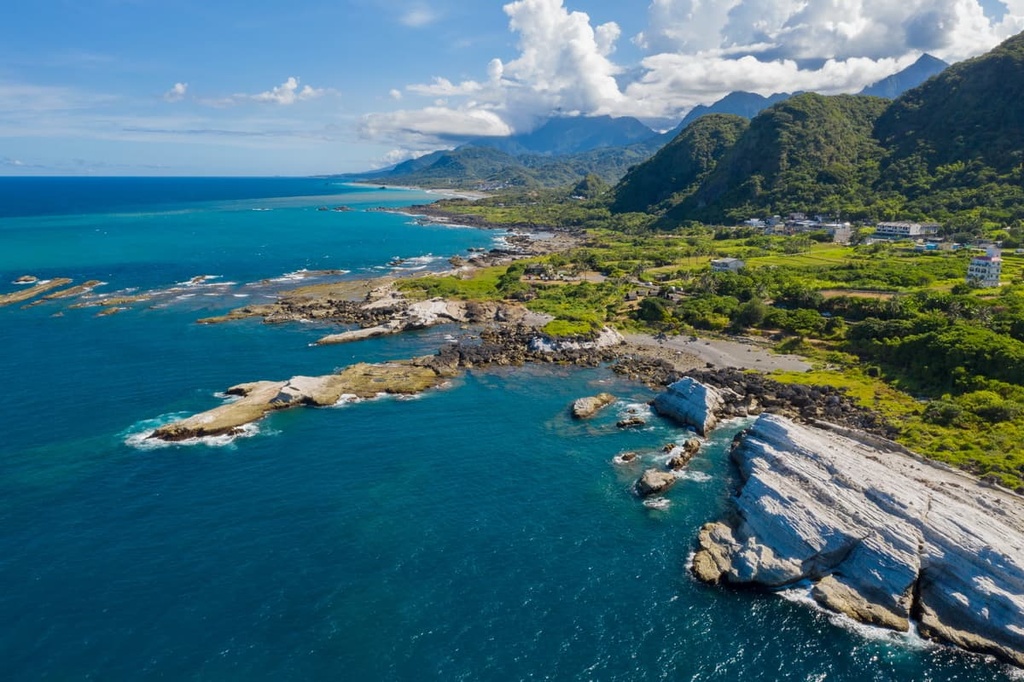
Huadong Coastal Reserve, which is also known as the East Coast National Scenic Area, begins in north-eastern Hualien City (花蓮市) and extends southwards to Taitung City (台東市). This linear reserve covers an area of 59,262 ha (146,440 ac).
Starting from the mouth of the Hualien River in the north, the Huadong Coastal Reserve stretches along the rugged coastline of Taiwan toward Taitung City. It borders Daxikou of Beinan Township (卑南鄉) in the south.
The reserve extends out into the Pacific Ocean until the water depth reaches 20 meters (66 ft). To the west, the Huadong Coastal Reserve's boundaries flank the first ridge of the Coastal Mountain Range (海岸山脈).
The coastal road of Highway 11 is an exceptionally scenic drive that runs along the eastern side of the reserve. It features the Pacific Ocean on one side and undulating, gentle coastal hills on the other.
Highway 9 runs parallel to the Huadong Coastal Reserve, too. It is the gateway to the stunning wonder of the East Rift Valley, which is also known as the Huadong Valley (花東縱谷).
Some of the other notable mountains of the Huadong Coastal Reserve include Chengguangao Shan (成廣澳山), Bai Shou Lian Shan (白守連山), Xingang Shan (新港山), and Dulan Shan (都蘭山).
The rainy seasons in the reserve are summer and winter. The notorious northeast monsoon carries torrents of rain while the summer typhoon season combines gale force winds with the intensity of heavy rain.
As the area rests along the coast, the temperature in the reserve is generally quite mild. Huadong Coastal Reserve enjoys a balmy yearly average temperature of 73°F (23°C). The temperature seldom falls below 59°F (15°C).
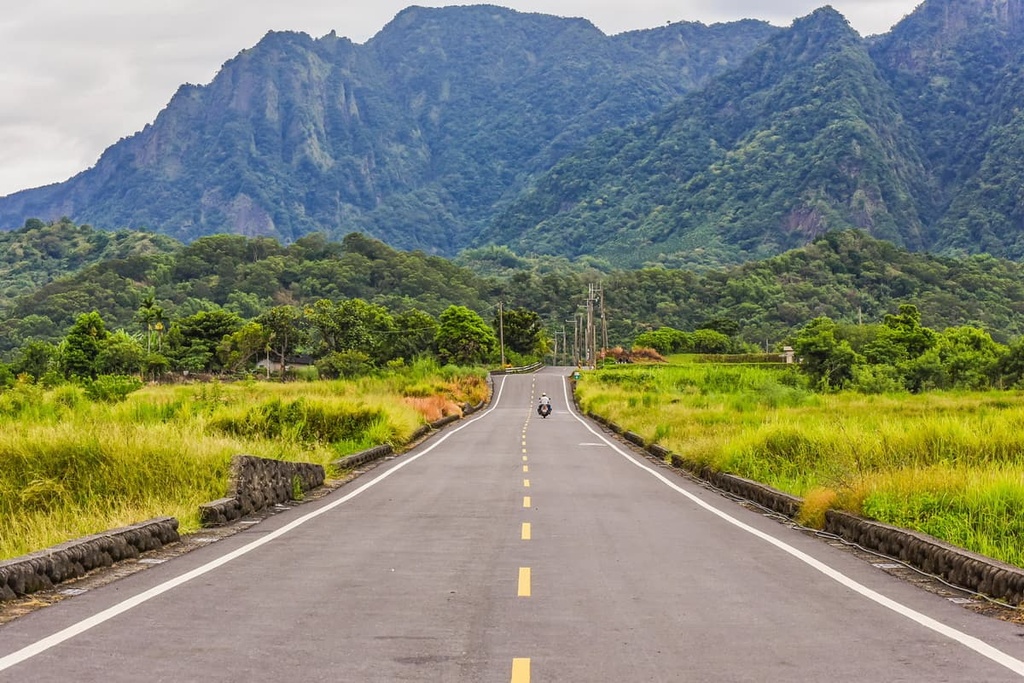
Areas of interest surrounding Huadong Coastal Reserve are Taroko National Park (太魯閣國家公園) in the north, Yushan National Park (玉山國家公園) in the west, the Pacific Ocean to the east, and Dawu Mountain Nature Reserve (大武山自然保留區) in the south.
The hills of Huadong Coastal Reserve belong to the Hai’an Range (海岸山脈), which are otherwise known as the Coastal Mountain Range.
The Hai’an Range is the smallest range of Taiwan’s top five mountain ranges, which consists of the Central Mountain Range (中央山脈), Xueshan Range (雪山山脈), Yushan Range (玉山山脈), and Alishan Range (阿里山山脈). Huadong Coastal Reserve contains 93 of the 189 named peaks in the Hai’an Range.
While the hills of Huadong are predominantly gentle in topography, they rise sharply near Taitung while flattening out near Hualien.
As the island of Taiwan was formed from the shifting of tectonic plates, the region is a mix of sedimentary and volcanic rocks. The rock strata in the reserve are mainly volcanic rocks that date back to between the Miocene and Pliocene.
Coastal rock formations scatter the coastline of Huadong. The best-known of these rock formations is Shitiping (石梯坪). Shitiping’s rugged terrain is composed of volcanic rock that stretches down the coastline for 1 km (0.6 mi).
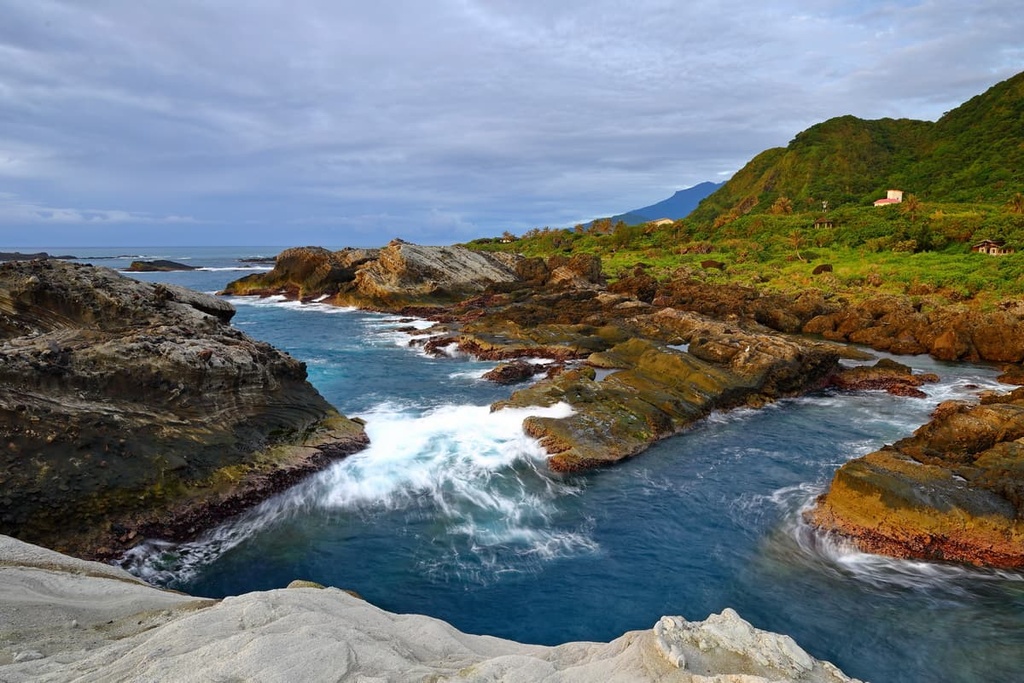
Coastal and marine plant species dominate the rocky cliffs and sandy shores of Huadong Coastal Reserve. Clusters of saddle vine are found on the beaches with the tung tree's moss spreading on craggy boulders. Seaweed and sea cucumbers are prominent in the waters of the Pacific Ocean.
The hills of Huadong Coastal Reserve feature low to middle elevation forests. Camphor trees are the dominant plant species in the mountains, interspersed with banyan trees, pine trees, and subcostate crape myrtle trees. Additionally, the tropical rainforests of the region feature many varieties of ferns.
The freshwater damselfish, butterflyfish, and red seabream are some of the marine wildlife of Huadong Coastal Reserve. As it is also a haven for birds, the Taiwan blue magpie, and the crested oriole are some of the most common bird species featured in the reserve.
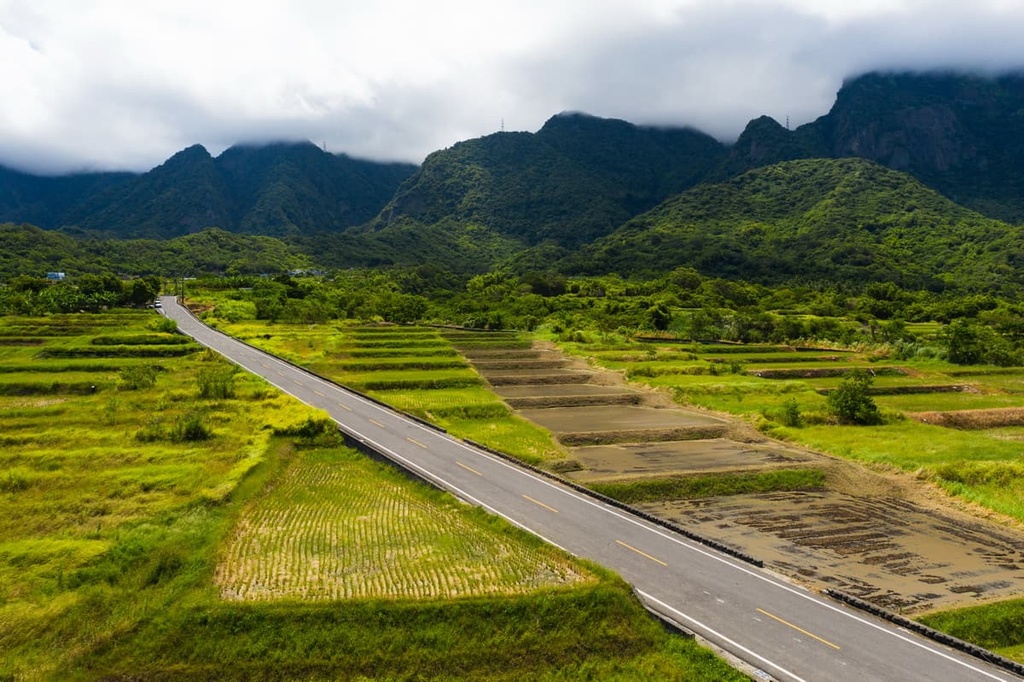
Huadong Coastal Reserve is home to one of Taiwan’s most important archaeological sites. In 1968, archaeologists uncovered artifacts dating back to the Stone Age at Baxiandong (八仙洞). These remains are evidence of human life some 30,000 years ago when people carved hunting tools from bones.
While Huadong Coastal Reserve features interesting archeological sites, it is also the ancestral home of the Amis Tribe.
The Amis traditionally live between Hualien and Taitung in the Huadong Valley and what is now the Huadong Coastal Reserve. The Amis is currently the largest Indigenous tribe in Taiwan with approximately 200,000 members. These days, the Amis are best known for their jubilant celebration of the Harvest Festival, which is held annually in July or August.
The Amis believe that a spirit resides in every living being; therefore, nature should be respected. The Harvest Festival is a testament to this, as it's a cheerful ceremony to thank the gods for their harvest crops.
The Amis perform animated dances and joyous songs, donning their traditional clothing, which consists of amazing headdresses, belts, and wraps that feature a rainbow of colors. Visitors are warmly welcomed to observe and even join the celebrations.
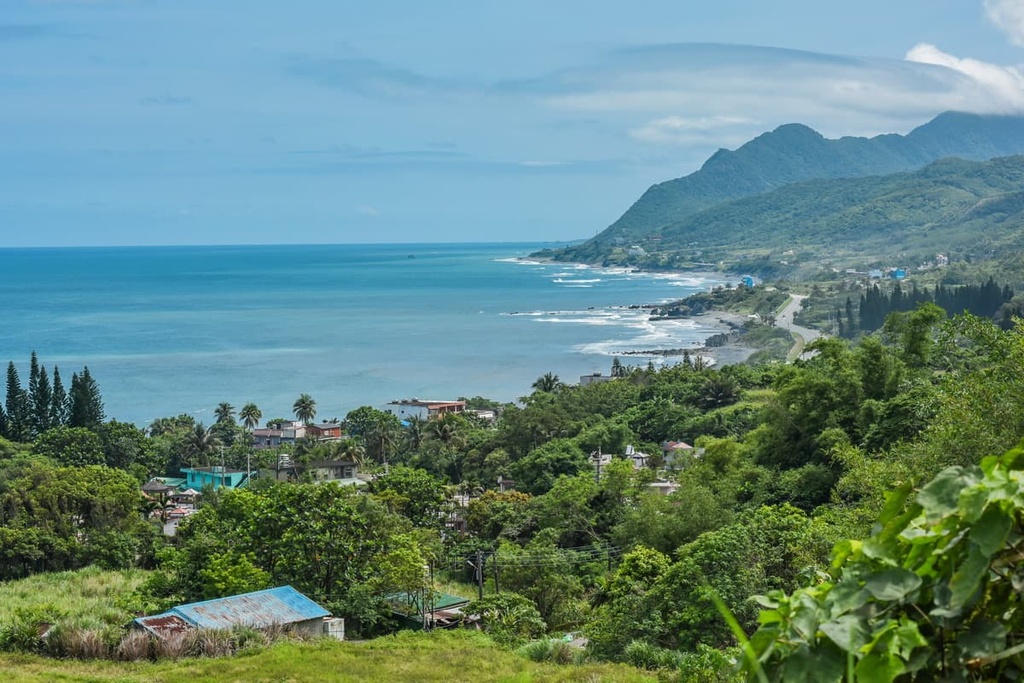
Huadong Coastal Reserve contains many attractions that can interest every visitor. Mountain climbing trails, hot springs, river rafting, and cultural villages are a few of the most coveted attractions in the reserve.
As the highest point in the Hai’an Range, Malaolou Shan is one of the Five Peaks of Taiwan, which consists of the tallest mountain in each of Taiwan's primary five mountain ranges. The highlight of the Malaolou Shan Hiking Trail is an unspoiled and evergreen forest of Taiwan camphor.
Hikers begin this 6.3 km (4 mi) trail at Jihara Bridge of Fengnan Village. Hikers commence the course by traversing the rock walls along the Beixi River. These boulders dip sharply in the Beixi River; thus, hikers should take care of their footing.
Once hikers pass the rock walls, they will make their way up the tallest peak of the Hai’an Range. A hardwood forest of camphor trees awaits hikers on their journey up the mountain.
The landscape is rampant with fragrant camphor, with leaves that create a forest canopy and block the harsh blazing rays of the Taiwan sun. Energy and life pulsate from the evergreen mountain woods along the path. The nature here is so beautiful that it looks like a charming scene out of a fairy tale.
Halfway up the mountain, giant camphor trees stand tall and proud, towering overhead. A smattering of camphor trees in the forest have collapsed, though, lying horizontally on the ground and creating a maze of hardwood.
Hikers can take joy in relishing the wondrous world of these verdant green mountain woods. These woodlands are often bathed in a fresh morning and afternoon mist that blows off the Pacific Ocean.
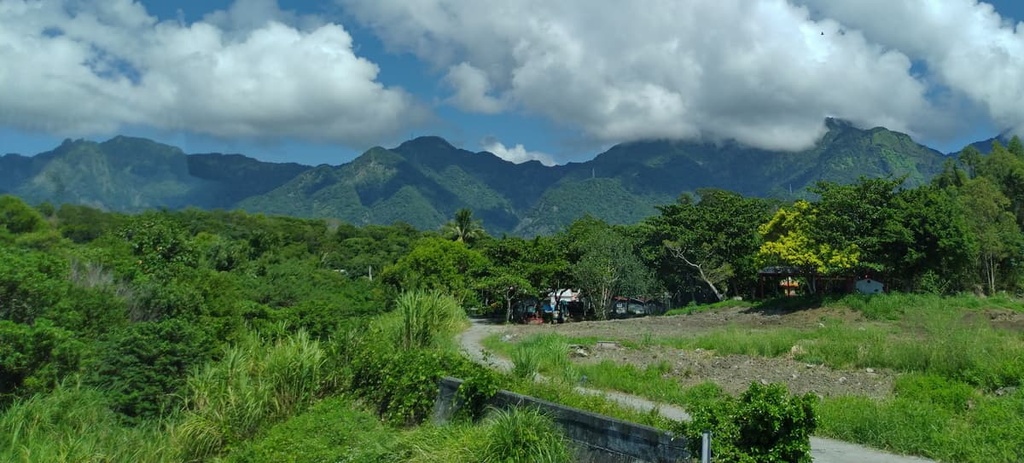
The summit of Malaolou Shan is overgrown; thus, hikers will see no prospects from here. However, the path down the mountain is magical, passing an emerald camphor forest of giant and wayward trees.
While not a major summit in the Huadong Coastal Reserve, the undulating slopes of Liushishishan (六十石山) feature a golden carpet of daylilies in August and September.
A 3 km (1.8 mi) hiking trail takes you to ten observation decks that are scattered along the mountain, offering stirring views of the surrounding coastal peaks and the 300 ha (741 acre) meadows of sunlit daylilies below.
From the highest observation deck, Wangyou Pavilion, hikers overlook the Huadong Valley floor while surveying the surrounding peaks of Antuku Shan (安土堀山), Chengguangao Shan, and Wanrenshan (萬人山).
In the afternoon, ocean mists roll in from the east, creating a sheet of fog that hugs the gently curved hills of the region. At night, the sky is so clear that entire constellations sparkle overhead.
One of the most striking features of the Huadong Coastal Reserve is the pock-mocked, weathered coastal terrace of Shitiping. The volcanic rock of various formations and appearances extends for 1 km (0.6 mi) along the shore in Fengbin Township.
The intensity of the whippy coastal winds and the crashing waves has contoured the rock into various shapes. The coastal territory of Shitiping consists of well-eroded terrain, including raised coral reefs and fantastic cliffs.
Meanwhile, the tidal pools of Shitiping contain a rich variety of wildlife, as the clear waters are the perfect habitat for crabs, starfish, sea cucumbers, and many beautifully colored fish.
In addition to its craggy potholed coastline, Shitiping is a well-known spot to observe whales and dolphins. Visitors can camp at Shitiping, too, in order to witness the incredible sunrise over the Pacific Ocean and the soft lapping of waves on Shitiping’s weathered rock.
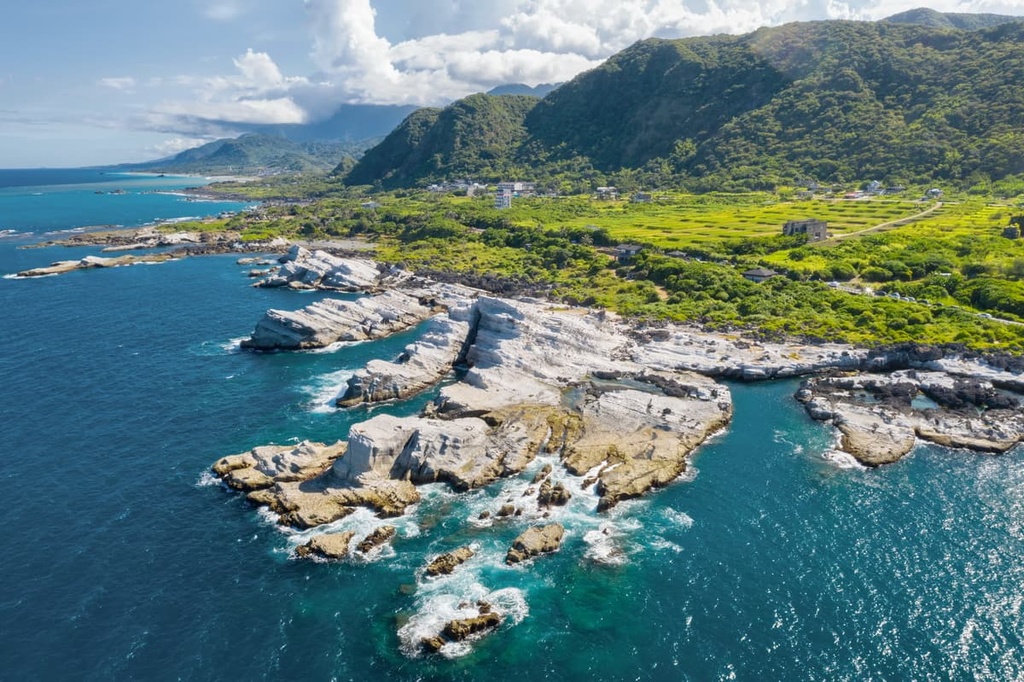
Also known as the Eight Immortal Caves, Baxiandong (八仙洞) features 16 eroded caves that cut into the reserve’s 150 meter (492 ft) high cliffs.
Made famous for its archaeological treasures, Baxiandong is steeped in folklore. According to local myths, the eight Chinese deities once crossed the oceans to reside in these weather-battered caves. Thus, locals have transformed the caves into Buddhist shrines in honor of these eight immortal residents.
As they are hidden from the sun, these damp caves are soaked in a continuous misty moisture.
Discovered in 1904 by Japanese hikers, Antong Hot Springs (安通溫泉) is steeped in the history of the Japanese Occupation Era.
Antong Hot Springs are most renowned for their picturesque setting. Nestled in a valley, the views of surrounding mountains from the hot springs are tranquillity at its finest. The springs lie on the north bank of the Antong River (安通溪).
By 1930, the Japanese had built a public bathing pool, thereby establishing this area as a major hot spring resort in Taiwan. Thus, many resorts, hotels, and inns have been established in the area over time, catering to visitors of all budgets. The Antong Hot Springs Hotel has retained its original Japanese architecture and décor for historical purposes.
The rotten egg smell hydrogen sulfide diffuses in the thermal waters of the hot springs, which are 140 to 151°F (60 to 66°C) in temperature. The springs contain properties that treat skin irritations, digestive problems and heal open wounds. In fact, they are one of Hualien’s top eight scenic spots.
Eastern Taiwan’s longest river, the Xiuguluan River (秀姑巒溪), is the premiere spot for whitewater rafting thrill-seekers in the reserve. Starting from its source at Xiuguluan Shan (秀姑巒山), the Xiuguluan River flows eastwards for 104 km (65 mi) toward Dagangkou, releasing its waters into the Pacific Ocean in the process.
The best time to ride the ferociously flowing waters of the Xiuguluan River is after heavy rains. Thus, strong typhoons, monsoons, or prolonged periods of rain are the ideal times for white water rafting in the region.
A 24 km (15 mi) course of the Xiuguluan River makes for great rafting as the river descends from the Central Mountain Range to the Hai’an Range, passing by 20 sets of forceful rapids in a huge gorge. The river dips 65 meters (213 ft) throughout its course.
The highlight of this rafting journey is the surrounding landscape. Sharp cliff walls imposingly stand like guards protecting the pristine canyons of the reserves. In fact, some boulders in these gorges are so well-eroded that they present a snow-white appearance to rafters on the river below.
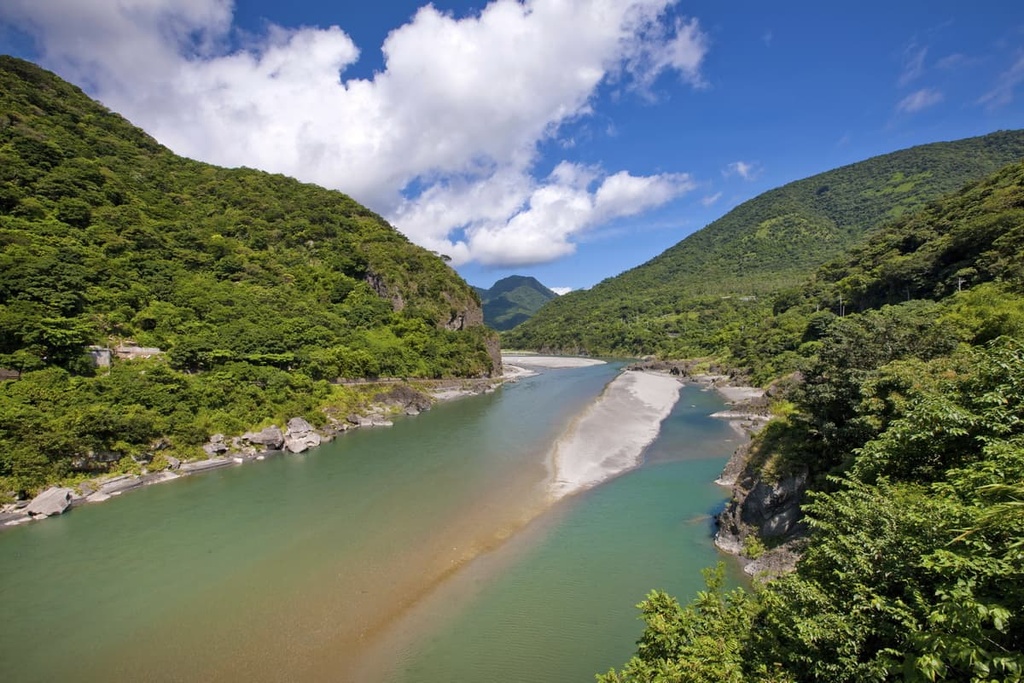
Due to its proximity to the Walami Trail, hikers usually treat themselves to this spectacle before or after their adventures. This short trail of 4 km (2.4 mi) in length is conveniently located just off Highway 30, an extension from Highway 9.
Na’an Waterfall (南安瀑布) is a seven-layered beauty with sheer cliffs as high as 50 meters (164 ft). The sound alone of the crashing rapids is impressive, especially in the rainy months of summer and winter.
While watching the surge of spilling, foaming water descend into pockets of aquamarine pools, hikers can also appreciate the thriving plant life growing along the terrain. The delicate pointed fingers of the forest’s many ferns elegantly frame the waterfall while dense shrubbery coats the landscape below.
Low elevation broad-leaved forests and dense camphor woodlands saturate the natural environment of Fuyuan Forest Recreation Area (富源國家森林遊樂區) near the reserve.
Here, a lingering fragrance from the hardwood camphor trees permeates the forest air. Low lying tree species of subcostate crape myrtle (Lagerstroemia subcostata) and the endemic Sloanea formosana are the most prominent plants throughout the forest.
March through August is the best time to view over the 30 species of butterflies that flutter their patterned wings in the humid woodlands of the recreation area. Additionally, the months of March, April, and May are firefly season. So, they offer a chance to see the night sky illuminated with busy, shiny orbs of light, as they flutter through the darkened sky.
Additionally, in the recreation area, the Fuyuan River (富源溪) snakes its way through the Fuyuan Valley, creating a mesmerizing sight against the weathered stone cliffs. The collective Fuyuan Waterfalls drape the valley in curtains of white-water sheets that follow the bustling river's trajectory into the valley below.
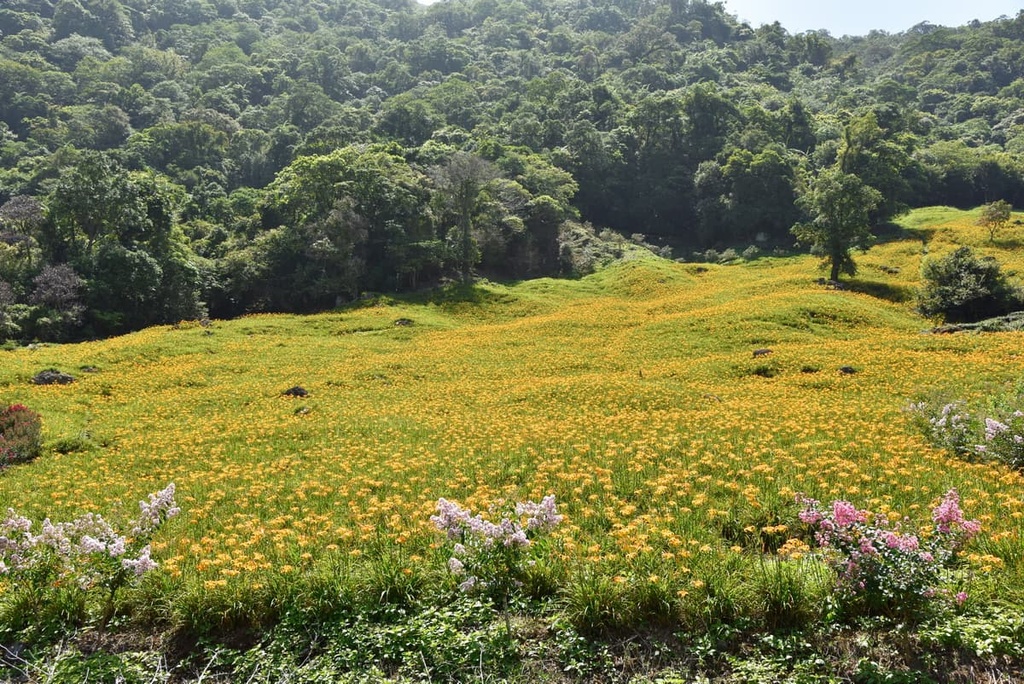
The expansive Luye Valley (鹿野谷) is a hive of activity, especially in the summer months when the annual international hot-air balloon festival is held in the region. Additionally, due to the incredible scenery of the southern section of the Huadong Valley and the Luye Highlands, paragliding is a popular activity in the Luye Valley.
The Taiwan Hot Air Balloon Festival is a well-received event in the region, attracting participants and visitors from all corners of the globe. Visitors enjoy relishing the fun and colorful display of buoyant orbs of every shade gliding across the sky while quirky cartoon characters make a joyous appearance overhead.
Meanwhile, the region’s patchwork fields feature a variety of tea plantations with dense shrubbery and wild foliage, with fruit farms displaying neatly planted rows of pineapples and loquats. Fulu tea is Luye Valley’s specialty, much loved for its punchy fragrance and bold taste.
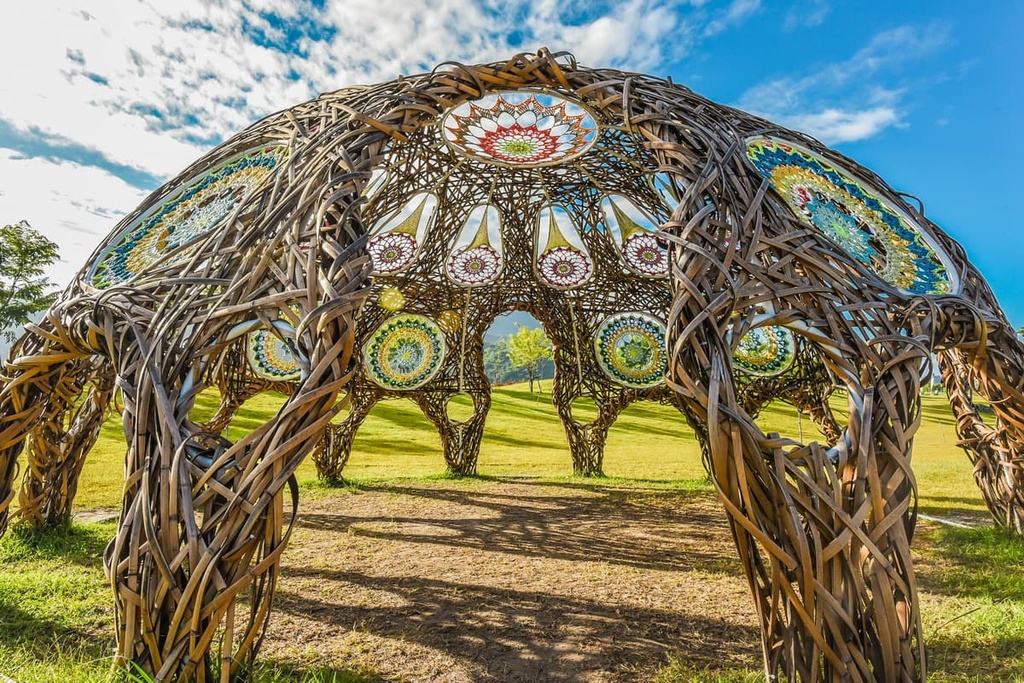
Hualien City and Taitung City are located at the opposite ends of the Huadong Coastal Reserve.
Both of these eastern Taiwanese cities offer visitors ample attractions amongst the most exquisite scenery of unspoiled coastlines of sandy bays and pebble beaches on Taiwan. Additionally, situated roughly at the halfway mark in the Huadong Coastal Reserve is the Amis settlement of Ruisui Township (瑞穗鄉), which is known for its hot springs and farmlands.
Taiwan’s eastern cities are less well-connected via rail and road than the network of trains and highways that link the western cities of Taiwan. For this reason, Taiwan’s east coast has a more relaxed vibe. However, Hualien City does attract many tourists due to its proximity to one of Taiwan’s classic destinations: Taroko National Park.
A trip to Taiwan is not complete until one visits this gem of the east coast. Here. sapphire blue waters sparkle against the dramatically sheer marbleized cliffs while emerald green peaks tower above Taroko Gorge. Taroko National Park contains many of Taiwan’s top 100 mountains; thus, visitors can enjoy exceptional panoramic views of the entire park during their hikes.
On the typically sunny Taiwanese weekends, many locals frequent Pine Garden, which is known for its historic buildings and beautifully manicured lawns. Pine Garden was a former Japanese Naval base where send-off parties for kamikaze pilots were held. The building is now an art gallery that showcases local artwork.
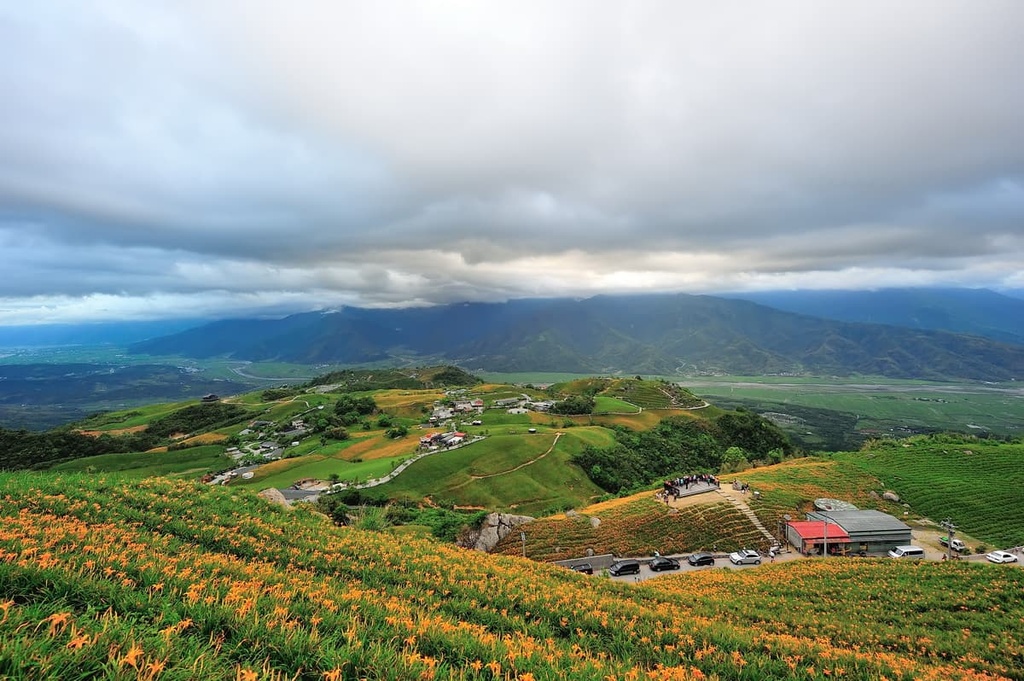
It is hard not to spot the chaotic delights of Taiwan’s night markets when visiting any Taiwanese city. Countless night markets start their working engines as evening descends, a flurry of activity and joyous merriment.
The Dongdamen Night Market in Hualien City is rated one of the best in Hualien. As it is the largest night market in Hualien, there are a plethora of stalls that offer everything from tasty exotic dishes to electrical appliances and clothing apparel. The local specialties to savor are fried wild boar, Taiwanese double-layer sausage, and bamboo rice.
While Hualien City has a distinctly mellow vibe compared to the bustling west coast, life in Taitung City slows down to an even more leisurely pace. Movement in the city is unhurried, locals enjoy slow living, and a dreamlike daze descends over enduringly charming Taitung.
For exceptional views of Taitung City, head to Liyushan Park. Visitors can climb the coastal hill of Liyushan (鯉魚山), where they can witness the incredible 360° views of Taitung.
Perched on this hill is Longfong Temple, where locals practice tai-chi in the morning. Visitors can climb the pagoda of Longfong Temple, from where they can access additional panoramic views.
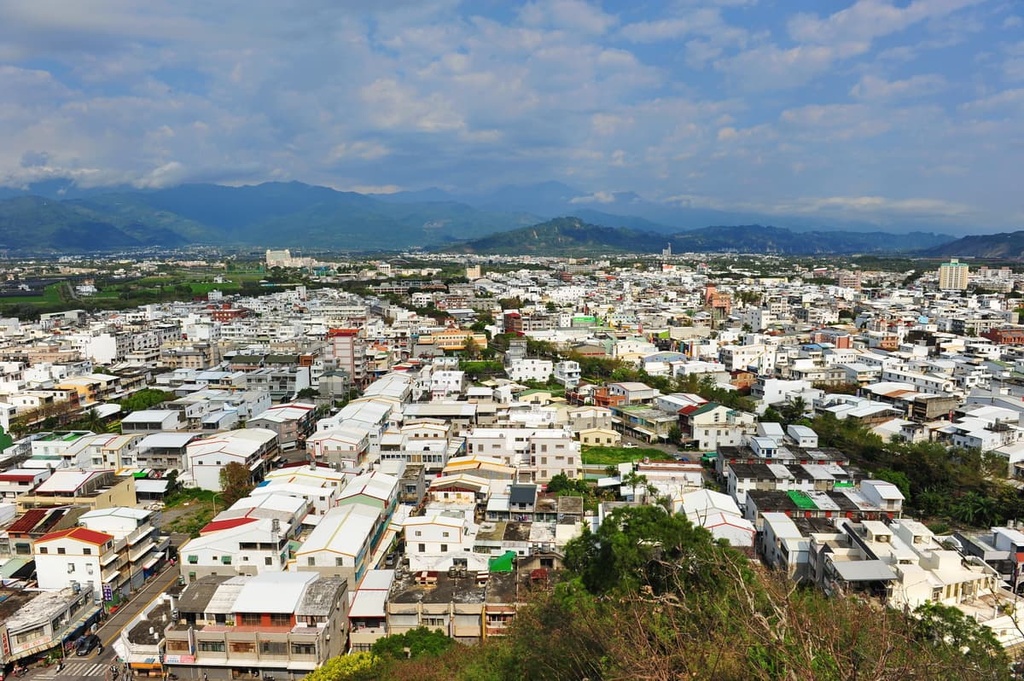
Zhiben Hot Springs is one of Taiwan’s most famous hot springs. Its picturesque setting tucked away in a sheltered valley is one of its main attractions, as the surrounding peaks add a layer of verdant shrubbery that luxuriantly wraps around the valley. The area was developed during the Japanese Occupation Era; thus, it features a simple yet elegant wooden architecture.
Sanxiantai Bridge is one of the most well-known marvels in Taitung. Situated in the northern township of Chenggong, Sanxiantai Bridge connects the island of Taiwan to Sanxiantai Islet. The striking appearance of the bridge is a fascinating eight-arched structure that resembles a Chinese dragon.
Ruisui Township is located along the banks of the Xiuguluan River. Thus, intrepid visitors seeking a whitewater rafting adventure often stop here during their travels. The Tropic of Cancer also runs through the township, and visitors can visit the monument that commemorates its passing.
However, what Ruisui Township is most known for is its hot springs. Developed in 1919 by the Japanese, Ruisui Hot Springs is a resort that offers visitors a luxurious experience.
The heated waters of the hot spring have a yellow tint and are rich in iron. Bathing in the thermal 118°F (48°C) springs is said to alleviate arthritis and skin conditions. According to local legend, if a woman bathes regularly in the springs, her chances of bearing a son are much greater.
Meanwhile, Ruisui Ranch is a large cow farm that allows visitors to feed grass to the grazing cows. The ranch is stocked with various fresh dairy products, such as ice cream, milk, cheese, and yogurt.
In addition to cows, ostriches also forage on the large fields in the township. There is ample space for children to play here, too. Plus, as the township is situated parallel to the Central Mountain Range, the imposing mountains create a dramatic landscape overhead.
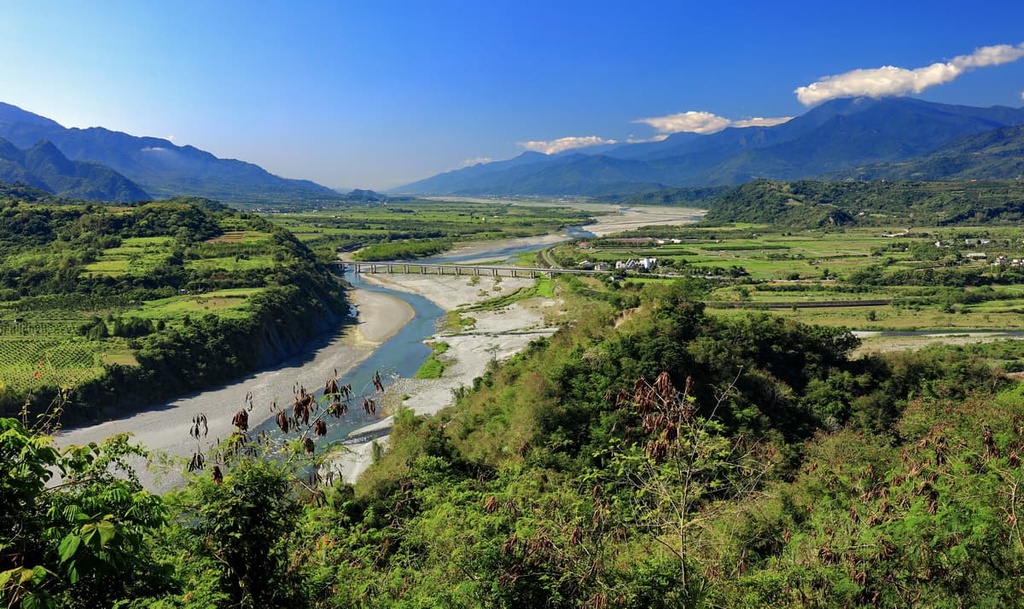
From the major cities of Taipei, Taoyuan, Hsinchu, Taichung, Chiayi, Tainan, and Kaohsiung, take the local express train to Hualien City or Taitung City, depending on if you want to start in the north or south.
Unfortunately, the eastern cities of Hualien and Taitung are not accessible via Taiwan High-Speed Rail due to the difficulties of crossing the Central Mountain Range.
As the Huadong Coastal Reserve runs along Highway 11, visitors should hire a car or scooter to access the linear reserve. Visitors can hire a car in Hualien or Taitung, whichever is the first point of departure.
It is a 170 km (106 mi) journey between these two cities. which serves as the gateway to the Huadong Coastal Reserve.
Explore Huadong Coastal Reserve with the PeakVisor 3D Map and identify its summits.
